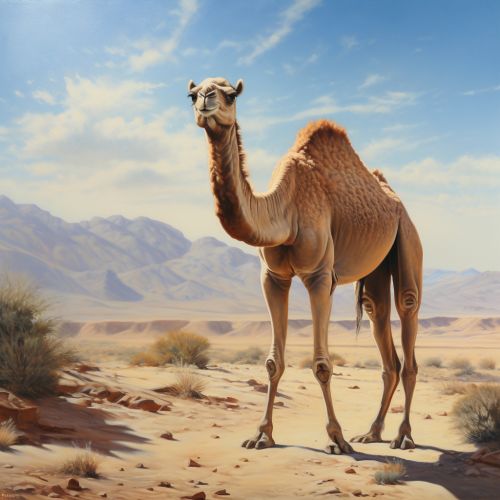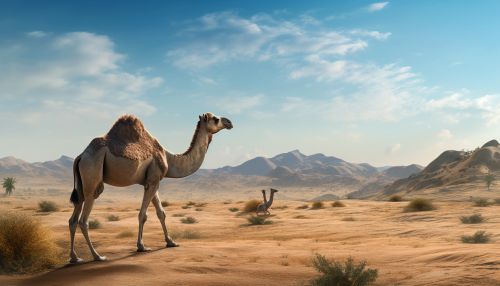Dromedary camel
Taxonomy and Evolution
The Dromedary camel (Camelus dromedarius), also known as the Arabian camel, is a large, even-toed ungulate with one hump on its back. It belongs to the family Camelidae, which also includes the Bactrian camel (Camelus bactrianus) and the wild Bactrian camel (Camelus ferus).
The dromedary is a descendant of the Protylopus, a small, short-legged creature that inhabited North America during the Eocene period approximately 40 to 50 million years ago. Over time, the Protylopus evolved into the Poebrotherium, a camelid that was more similar in size and shape to the modern dromedary. The Poebrotherium eventually gave rise to the genus Camelus, which includes the dromedary, the Bactrian camel, and the wild Bactrian camel.


Physical Characteristics
The dromedary is distinguished by its single hump, which is composed of fat and can weigh up to 80 kg. This hump allows the dromedary to survive in harsh desert conditions, as it can provide both food and water when resources are scarce. The dromedary's body is adapted for desert life in other ways as well. Its long legs keep its body away from the hot desert sand, and its broad, tough feet are well-suited for walking on sand. Its eyes are protected from sand and dust by a double row of long lashes, and its nostrils can be closed to keep out dust.
The dromedary has a body length of 2.3 to 3.5 meters, a shoulder height of 1.8 to 2 meters, and a weight of 300 to 600 kg. Males are generally larger and heavier than females. The dromedary's coat varies in color from light beige to dark brown and serves to protect the animal from the sun's intense heat during the day and the cold desert temperatures at night.
Behavior and Ecology
Dromedaries are social animals that live in herds of up to 20 individuals, typically consisting of one dominant male, several females, and their young. They are primarily active during the day, spending the majority of their time foraging for food. Dromedaries are herbivores and their diet consists mainly of foliage, dry grasses, and desert vegetation.
Dromedaries have a unique method of conserving water. They can tolerate a body temperature range from 34°C to 41°C, allowing them to conserve water by not sweating until their body temperature reaches the upper limit of this range. They can also withstand up to 30% weight loss due to dehydration, and can rehydrate by drinking up to 100 liters of water in just 10 minutes.
Distribution and Habitat
Dromedaries are native to the arid regions of the Middle East and North Africa. However, they have been introduced to other parts of the world, including Australia, where they have established a feral population. They are well-adapted to desert environments and can be found in a variety of desert habitats, from sandy to stony deserts and from arid to semi-arid areas.
Relationship with Humans
Humans have used dromedaries for thousands of years for transportation, milk, meat, wool, and leather. They have played a crucial role in the economies of desert communities, enabling trade and travel across vast desert landscapes. In modern times, dromedaries continue to be used for these purposes in many parts of the world. They are also used in racing and tourism, and are considered a symbol of the Middle East.
Conservation Status
The dromedary is not currently considered to be at risk of extinction. However, it faces threats from habitat loss due to human activities such as agriculture and urbanization. In addition, the introduction of motorized vehicles has led to a decline in the use of dromedaries for transportation, which could potentially impact their population in the future.
